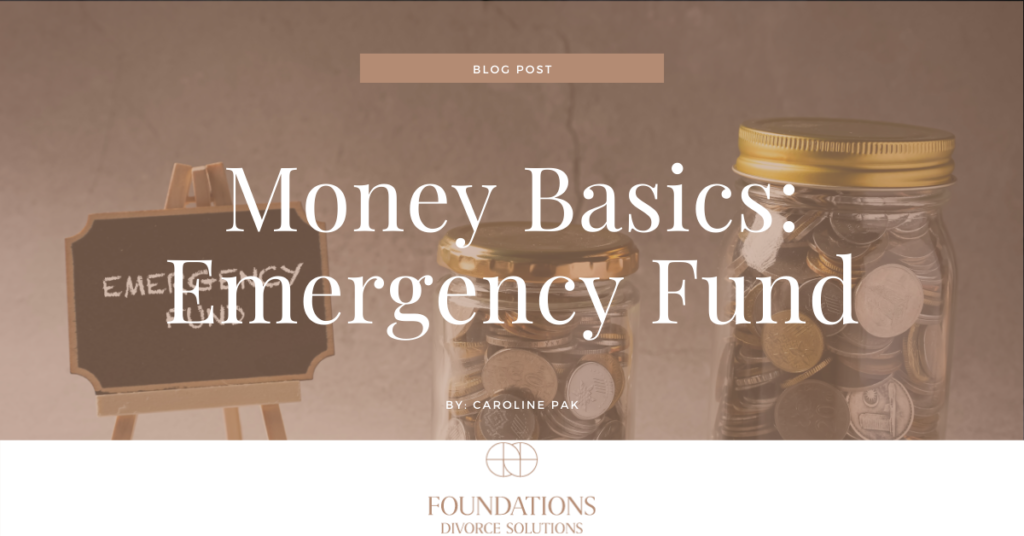On Build Your Foundations, we have been diving headfirst this month, into the Money Basics Series. So far, we have established the ABC’s of basic budgeting, setting financial goals such as eliminating debt and establishing credit. In our final week of the series, we will review another key component of money basics – the need for an emergency fund.
Recently, I had an initial consultation with a husband who wanted to see if I would be willing to meet with him and his wife to talk through areas where they did not see eye to eye on their household budget and spending habits. He felt very anxious that if the spending kept up at the current pace, there would not be enough money. After asking a few questions, it turned out that every month, after bills were paid, there was a deficit of about $1500. I was honest with him. I let him know that I completely understood his concerns about the household finances. Being $1500 in the red every month is not a fun place to be and it is completely valid to feel stress and anxiety. In the ABC’s of basic budgeting, we established that “B” is for “Be in the Black”. $1500 in the red every month adds up quickly! For some of you, this may be your entire month’s budget and this is very scary but for this gentleman and his family, it turned out that they had an emergency fund to cover them in case something else happened. This emergency fund, once I probed a little bit further was enough to comfortably take care of the family for a minimum of 10 months without any other income being generated. The second part of my conversation with him was advising him to have a heart-to-heart chat with his wife and to meet her in her needs FIRST, to set aside the household finances, and to be focused on the root cause of the spending, and not the spending itself. It was clear to me as the third party that the spending issue is a message to him because a need in her was not being met. And he was feeling like his need to stay within the budget to ease his stress was also not being met. The fact that they have this emergency fund has now given them some room to have some difficult conversations, not about money, but about their unmet needs and how they can work towards meeting each other’s needs with love, grace, and care. As they keep the conversation open and the walls down, their marriage is going to find new hope and a new spark.
HOW TO START YOUR EMERGENCY FUND
I’m going to be straight with you. If you have not lived within a budget, and if you are not the CEO of your home, thinking about starting an emergency fund, let alone figuring out a budget may be overwhelming. If you are living paycheck to paycheck and feeling stressed about possibly losing your job, this may not seem like the right thing to do at this exact moment. But, we can take one small step and then another to help build your emergency fund. Dave Ramsey in his Debt Snowball method encourages people to start with $1000 in an emergency fund. This is may seem like too much to some when you can’t even imagine where you can scrape enough pennies together to get $100 in one place but it is possible.
I would like to share an easy strategy on how to start your emergency fund. It will take a little effort at first but once the system is set in place, you don’t have to think about any other steps. Just let the savings do their thing automatically!
OPEN A SAVINGS ACCOUNT
The first step is to open a savings account. Maybe an online savings account or an account at a bank where you don’t normally bank, or a credit union that is in your neighborhood but not convenient enough for you to go to regularly. Do not open this savings account at your regular bank! The purpose of this savings account is to know it is there for emergencies but to pretend like it doesn’t exist. This account is not for you to have access to it unless you really need it FOR AN EMERGENCY.
If this bank has online access, set up online statements. Once again, you want to pretend like this account does not exist. Receiving paper statements to let you know that balance defeats the purpose of pretending like this does not exist. Also, set up three separate alerts – one alert for when funds are deposited, so that you know there is money going in. The second alert for when funds are taken out because unless you have an emergency, no money should be leaving this account. And the last alert is for when the balance is over $1000.
Before you leave the bank, be sure to get the exact routing and account number for the next step.
SET UP A DIRECT DEPOSIT
Once the savings account is opened with the minimum amount, the next step is to go to your work’s HR payroll department or log into your HR’s pay website or online app and set up a direct deposit. You will need the new saving account’s routing and account number. You probably already have a direct deposit set up for your entire paycheck to go into your household account. We will be splitting this direct deposit from now on.
The type of direct deposit you will set up is a dollar amount and not a percentage. The amount you set up is up to you. Whether it’s $10 per pay period or $100 per pay period, whatever amount that feels like it may be just slightly too much for you is what you should start with. Once you set up the direct deposit, allow for the savings to have one full month’s direct deposit and reassess whether the amount you are putting into the savings account is creating a strain on your budget, if you feel okay about the amount, or if you think you can put a little bit more into this savings. Adjust your direct deposit amount accordingly. Just be sure not to stop the direct deposits altogether. However small the direct deposit amount is not the issue. Just having funds going into this emergency fund automatically from your paycheck is the goal.
For now, the goal is to get $1000 in your emergency savings. Once you reach the $1000, remember the third alert you set up when you opened your account? You will get an email or a text to let you know that you reached the $1000 goal. Congratulations on reaching the first $1000 into your emergency fund!
Now it’s time to think about the next goal you want to reach. If you are already working with a household budget, you should know already how much each month you require to keep a roof over your head, feed the family, and have a little bit of extra to do something special for yourself. If you need $3,000 to keep your home together, set the next goal, and the alert to be set is $3,000. Let’s grow the emergency fund to cover one month’s worth of expenses. Then grow your emergency savings to $6,000 and so on, until you have reached 6 months to a year’s worth in emergency fund.
Even if each step feels like it’s taking forever, don’t give up. I’ll let you in on a secret. Once you set up the initial emergency fund, you may find that creating this cushion starts to become fun and you get to a place where you never want to touch the money you saved, because you worked hard to get to this place.
IN AN EMERGENCY SITUATION
Even in an emergency situation, you may find yourself not wanting to touch this money. But when you have an emergency, it’s okay to take the money out. And yes, I said when and not if. Everyone has emergencies. Whether the car breaks down, you get a flat tire and now need to replace all the tires or something happened in the house and insurance doesn’t cover it, emergencies happen and this is why you have the emergency fund. Just know that once you are able, work towards building that balance up again, and don’t beat yourself up. You started this fund when you felt like it was impossible and now look at how far you have come. Trust that you will be able to get back to replenishing the money that you had to take out by forgetting about the emergency fund and continuing to allow the savings to automatically happen through the direct deposits.
Remember the gentleman I had the initial consultation with? He worked hard to build up his emergency fund and he knows how hard it was to save this amount and he too is also at this place where he does not want to touch it. And it is very understandable because starting to save is not the easiest thing to do and once you start saving, you don’t want to have to start all over again. But take moments to celebrate the wins and the accomplishments and goals you have achieved.
At Build Your Foundations, we are here to help you put together a budget, set financial goals, help you work towards getting out of debt, help you on your journey to build your credit history, and even help you set up an emergency fund. Each individual person’s money journey is different and should be tailored to fit you as an individual and for your specific needs. We would love to meet with you to help you customize your money basics with a free consultation.




